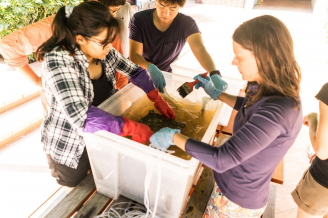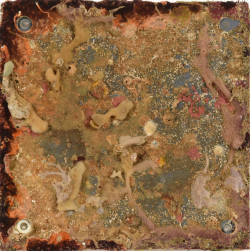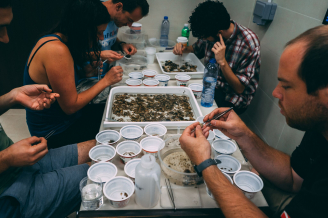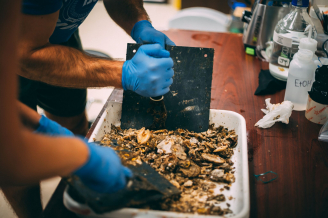Media
Taking the pulse of the ocean – HKU launches “MarineGEO-Hong Kong” as part of global initiative to quantify marine biodiversity
04 Feb 2018

ARMS settlement plate deployed in Tung Ping Chau for two years. Many of these eight-level ARMS structures were found to have over 300 visible organisms living within.
Local and international scientists joined with HKU’s Swire Institute of Marine Science and School of Biological Sciences for an intensive, 10-day marine life survey through some of Hong Kong’s most disturbed and pristine marine environments. From the heavily impacted, inner Tolo Harbor to the more isolated, coral rich Tung Ping Chau, scientists identified over a thousand representative specimens of fish, crabs, snails, bivalves, worms and more across an estimated 300-400 total species.
Scientists are still working to identify each of these specimens which are also being documented through high resolution photography and genetic characterization, or barcoding. In fact, many specimens are stumping the expert taxonomists suggesting that there will be newly described species of hermit crabs and bivalves to come. Not all biodiversity is good news however, several invasive species were also identified which can cause disruptions to local ecosystems. In addition to identifying all of those organisms that they could see, scientists will use the latest technologies in genetic identifications to detect organisms that are too small to be recognized by the naked eye.
The survey methods were developed by the Smithsonian Institution’s Marine Global Earth Observatory research program (MarineGEO), which is “the first long-term, worldwide research program to focus on understanding coastal marine life and its role in maintaining resilient ecosystems around the world”. In 2016, The University of Hong Kong became the first official MarineGEO site in Asia and hopes to serve as a node for future expansion in the region.
One of the strengths of the MarineGEO project is the standardization of methods used to quantify biodiversity. The multilevel settlement structures, or ARMS, are approximately 0.5 m2 and resemble a marine invertebrate version of Hong Kong’s famous high-rises. To survey the existing biodiversity HKU scientists deployed twelve ARMS in Hong Kong in May 2015 and collected them in October 2017, with plans to deploy and collect data for 40 more ARMS across Hong Kong as far west as Lantau Island. In addition to providing a baseline biodiversity assessment, through time, this legacy project will allow scientists and governments to better evaluate human impacts on the marine environment and which interventions are most efficient at preserving biodiversity. To find out more and keep track of ongoing projects, visit the website at https://marinegeo.si.edu/hong-kong-china.
“MarineGEO is a legacy project which SWIMS has committed to lead for years to come. Although the project is global in scale, our grassroots efforts provide a new means of monitoring Hong Kong’s changing marine environment from negative factors like climate change and development, and positive factors like improved management and restoration, said” Dr. David Baker, Project Principal Investigator.
“The amount and diversity of tiny creatures in Hong Kong waters is astonishing. Even more so considering how impacted the habitat is by the millions of people here,” added Dr. Till Roethig, SWIMS post-doctoral fellow. “It was exciting to connect everyone, from local students to global scientists, to the amazing diversity which makes Hong Kong a special and important site for conservation in the region,” said Dr. Shelby McIlroy, also a SWIMS post-doctoral fellow.
"As undergraduates, we had fun participating in this project. There were many benthic organisms that we had never seen before. The beautiful colours of sea slugs and the sound that snapping shrimps made were very memorable. We were also lucky to witness the biodiversity along with all the admirable researchers," Chan Mei Yin, Chan Sze Wen, Lee Tsoi Tao Esther, Tsui Teresa Ka Wing and Wong Yu Yeung, Gary echoed.
For media enquiries, please contact, please contact Ms Cindy Chan, Senior Communication Manager of HKU Faculty of Science by phone at (852) 3917-5286/ 6703-0212 or by email at cindycst@hku.hk
Image download: http://www.scifac.hku.hk/news/media?page=1
The ARMS were transported back to HKU and each plate was removed one at a time while making sure not to lose any organisms large or small.
A single plate from one ARMS structure measures ~25 X 25 cm. High resolution photographs like this one allow for visual identification of attached organisms including sponges, encrusting algae, tube worms, ascidians, and more. Scientists will look at not just who is there but also how their abundance changes around Hong Kong.
Students and scientists brush off and pick through everything that is not firmly attached to the ARMS plates looking for organisms such as crabs, shrimp, snails and more. These are sorted by eye, counted, and passed to a taxonomic expert. They will also be sampled to determine the genetic sequence that corresponds to the taxonomic identification and build a library of genetic diversity for future use.





